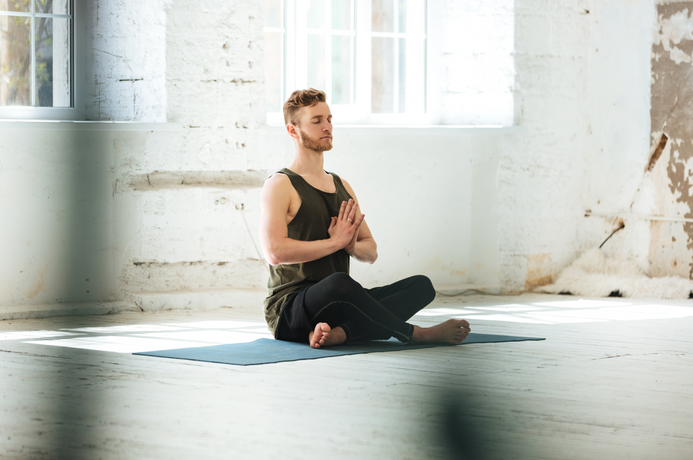- Vous avez pas d'articles dans votre panier.
How to Learn Meditation in Just 3 Easy Steps
01
Dec
Meditation is a great way to sneak some ‘me’ time into your busy life. It costs nothing but 10-20 minutes of your time, which is something we can all afford. If you’ve ever wanted to learn how to successfully meditate and discover the real benefits of meditation, then you’re reading the right article. That’s because you’re about to discover our easy 3 step method for relaxation and meditation.
And the good news is that this method works even if you’ve never done it before, you know nothing about meditation, or you have never done a meditation course before.
Read on...
Step 1: Find a nice, quiet space in your home where you can meditate.
Many people who are new to meditation don’t even realize that they need to do this step before they can start meditating.
So, the first thing you need to do is find a cozy, comfortable space, which is not accessible to pets. This space should always be clean and free of clutter. This is the place where you come to unwind, focus on yourself, rest, and relax. It is a place of peace and serenity.
You’ll find that this part of the process goes much more smoothly if you apply these tips:
-
make sure that your back is propped up and straight during meditation, do not slouch. You can lean against a wall, but your back should be straight.
-
do not let your pets sleep in your meditation space or lay in your lap while you’re meditating. Our pets love us and want to be with us at all times, but you should be undisturbed while meditating, especially if you are a beginner.
-
Inform your family or housemates of your meditation time, especially if you are sharing a room. You should not be disturbed by opening doors, rustling papers, or someone tiptoeing through the room. Of course, this is not always possible, but make your best effort to have peace and quiet for at least 10-20 minutes a day.
Once you’ve successfully claimed your meditation space, then you can move on to the next step…
Step 2: Meditation is not ‘emptying your mind’ or ‘concentrating’, empty mind and concentration are the results of meditation.
The next thing you need to do is understand that meditation is not an effort to unfocus. What you resist, persists. The more you try to focus on letting go, the stiffer you become and your mind will be flooded with more thoughts. Let your thoughts come, instead of trying to get rid of them. The trick is to see the thoughts coming, acknowledge them and then let them pass. They can keep coming, it’s fine as long as you also let them pass on (and make way for new ones that will also come and go).
Trying to get rid of thoughts is a very common mistake among people who just started doing meditation. The result is frustration instead of a clear, relaxed mind.
So let us share with you the top 3 mistakes that are holding you back in meditation and how to avoid them:
-
Comparing yourself to others.
Your super spiritual friends have been telling you how they were launched into space in their meditations, they are describing experiences that you can only dream of having and it’s making you anxious: ‘What am I doing wrong?’, ‘Why do I not have these intense experiences?’. We are telling you right now, drop the comparisons. Everyone has their own unique experience in meditation, and yours being different from others’ doesn’t mean that you are doing something wrong.
Making meditation a chore, something you HAVE TO do.
Instead of judging yourself for not meditating every day (or whenever you tell yourself you have to do it), think about WHY you are doing it - e.g. to improve your focus, rest, relax, concentrate better at your job or in school, feel good about yourself and the world, etc. Your brain will respond better to this question than to self judgement, self blame and guilt for not doing it.
Being inconsistent.
You have dealt with mistake no2 and meditation is not a chore anymore, but you are still doing it sporadically and you feel like you are not getting any results. When we start doing something new, like, for example, running a marathon, we have to start slowly and gradually improve. We have to run every day to get into shape to run 21km. Meditation is the same: it is like mental hygiene, we have to do it every day in order to feel the effects of a clear mind.
Step 3: Meditate for maximum 10-20 min every day
At this step you’re likely to notice that your meditation time may vary from day to day. This is perfectly fine. So, what you need to do is start with 5 min and then naturally see if your meditation time is increasing. You don’t need to set your goals to do hours of meditation. Sometimes less is more, and you can have a deep experience in just 15 min, rather than making yourself stiff sitting for an hour, trying to reach nirvana.
We as humans are very often full of concepts about things we should or shouldn’t do and how we should do them. Meditation is an effortless practice and its results will manifest in your life after you have established a regular practice. Remember not to be too hard on yourself, let it happen naturally.




